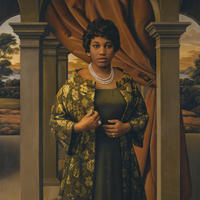More about Bradley Sawyer Phillips
Works by Bradley Sawyer Phillips

Sr. Contributor
Bradley Sawyer Phillips was an accomplished painter and producer of plays in his own right, but he is largely remembered for his brief marriage to a more famous woman who once stole Joan Mitchell’s man.
At a time when female figures of the modernist avant-garde often suffered from the Lee Krasner effect - their achievements belittled compared to more celebrated male partners - Phillips conversely played second fiddle to poet and playwright Violet Ranney Lang.
Lang, affectionately called “Bunny,” was a blue-blooded Boston debutante who dropped out of college to join the Canadian Women’s Army Corps during World War II, danced in a burlesque chorus line, and had a legendary collection of outrageous costumes she wore in everyday life. She became one of the most prominent members of the New York School of creative intelligentsia, writing many plays, including Fire Exit, a feminist reclaiming of the Orpheus myth. Phillips collaborated with Lang and produced some of her plays, but Lang had a lot of wild oats to sow before settling down.
Bunny Lang was...a lot. Even one of her best friends, Alison Laurie, admitted, “To be with Bunny was like alcohol: at first exhilarating, but in the end destructive.” She delighted in shocking her anti-Semitic Bostonian family when she brought home Jewish abstract expressionist Michael Goldberg and announced she was planning to marry him. Equally vexed by this for non-bigoted reasons was artist Joan Mitchell, who happened to be in love with Goldberg at the time. She was fiercely jealous of what she viewed as a “threesome” between Lang, Goldberg, and Mitchell’s favorite poet, Frank O’Hara.
The marriage to Goldberg never panned out, though their hot affair continued, complicated by Lang’s battle with Hodgkin's Lymphoma. However, it was Phillips who ultimately won the waiting game for Lang's hand. Tragically, even Lang’s indomitably quirky spirit was no match for her disease, but Phillips married her just before her death at the age of 32. He seems to have been devoted to Lang’s memory, keeping up correspondence with mutual friends such as author Djuna Barnes regarding posthumous publication of her works. He also published Alison Laurie’s memoir memorializing his dead wife, which was illustrated by their friend, macabre goth icon Edward Gorey.
Bradley Phillips’ own background, while it lacks the theatrical panache of his eccentric wife’s, is nonetheless compelling. His great-grandfather, Union soldier Rufus Harnden, claimed to have fired the shot that killed General Stonewall Jackson, refuting the accepted account that Jackson died by Confederate friendly fire. If true, Harnden could be credited with saving the Union, as Robert E. Lee stated the South would have won the Civil War if they’d had Jackson at Gettysburg. Bradley Phillips’ father, Philip Phillips, was an archeologist noted for his groundbreaking excavations of Native American sites, and his mother was Ruth Wilma Schoellkopf, daughter of Gilded-Age industrial tycoon Jacob Friedrich Schoellkopf Jr.
The family hailed from Buffalo but settled in Cambridge Massachusetts, becoming prominent New England citizens. Phillips’ sister, literature professor Sayre Sheldon, was a Radcliffe alum of 1948, and one of the first women to attend classes with men at Harvard, though she had to wait to sit until all the male students were seated. This must have been galling to Sheldon, who went on to become an outspoken feminist, antinuclear activist, and civil rights leader who marched with Dr. Martin Luther King, Jr. in Montgomery, Alabama. She is still alive as of 2022, and attributes her longevity to water aerobics, yoga, and swimming. She has also been instrumental in archiving her brother’s personal papers and preserving his artistic legacy through museum donations.
Phillips’ personal life and body of work suggest he shared his sister’s progressive values. In addition to his unconventional marriage to and collaboration with bohemian iconoclast Lang, some of his finest portraits are regal depictions of Black luminaries, including opera diva Leontyne Price, fellow artist Richard Yarde, and ‘70s man of fashion Alexander Hicks (possibly smoking a joint, no less). His choice of subjects may reflect a commitment to racial justice. Some of these were executed in pastel, and commentators have noted Phillips’ aptitude for that unforgiving medium in addition to his skill as a painter. His precise motivation for elevating Black excellence may not be certain, but the beauty of the work speaks for itself.
Sources
- “Catching up with the Class of ’48.” The Harvard Gazette, November 28, 2018. https://news.harvard.edu/gazette/story/2018/11/catching-up-with-harvard….
- Cutter, William Richard. Genealogical and Family History of Western New York, Vol. I. Buffalo, NY, 1912.
- “The Fenway (Richard Yarde).” The Boston Athenaeum, accessed September 22, 2022, https://www.bostonathenaeum.org/paintings-sculpture-online/fenway-richa….
- Gabriel, Mary. Ninth Street Women: Lee Krasner, Elaine de Kooning, Grace Hartigan, Joan Mitchell, and Helen Frankenthaler: Five Painters and the Movement That Changed Modern Art, New York: Little Brown, 2018. https://books.google.com/books?id=afQlCwAAQBAJ&pg=PT409&lpg=PT409&dq=vi…% 2C%20burlesque&f=false.
- Harvard Library. “Bradley Phillips Papers.” Accessed September 22, 2022. https://hollisarchives.lib.harvard.edu/repositories/24/resources/3490.
- Harvard Library. “V. R. Lang Papers.” Accessed September 22, 2022. https://hollisarchives.lib.harvard.edu/repositories/24/resources/1587.
- Kennings Editions. “Previews & Supplements: Don Share on V.R. “Bunny” Lang.” March 4, 2010. https://www.kenningeditions.com/kenning-editions/previews-supplements-d….
- Loyola University Chicago Digital Special Collections. “Edward Gorey at Harvard University: V.R. Lang.” Accessed September 22, 2022. http://www.lib.luc.edu/specialcollections/exhibits/show/gorey/edward-go….
- National Portrait Gallery. “Leontyne Price.” Accessed September 20, 2022. https://npg.si.edu/object/npg_NPG.91.96.
- “Philip Phillips, Prominent Archaeologist.” The Buffalo News, December 13, 1994. https://buffalonews.com/news/philip-phillips-prominent-archaeologist/ar….
- Sheldon, Phoebe. Rufus: A Boy’s Extraordinary Experiences in the Civil War. Brook Hollow Press, 2018. https://books.google.com/books?id=xdZ7DwAAQBAJ&printsec=frontcover&sour….
- Smee, Sebastian. “ ‘Checkout’ holds a moment in balance.” The Boston Globe, September 28, 2010. http://archive.boston.com/ae/theater_arts/articles/2010/09/28/checkout_….










